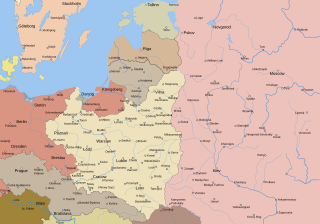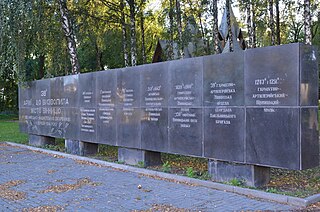
The Latvian National Armed Forces, or NBS, are the armed forces of Latvia. Latvia's defense concept is based on a mobile, professional rapid response force and a reserve segment that can be called upon relatively fast for mobilization should the need arise. The National Armed Forces consists of Land Forces, Naval Forces, Air Force and National Guard. Its main tasks are to protect the territory of the State; participate in international military operations; and to prevent threats to national security.

The military occupation of Latvia by Nazi Germany was completed on 10 July 1941, by Germany's armed forces. Initially, the territory of Latvia was under the military administration of Army Group North, but on 25 July 1941, Latvia was incorporated as Generalbezirk Lettland, subordinated to Reichskommissariat Ostland, an administrative subdivision of Nazi Germany. Anyone not racially acceptable or who opposed the German occupation, as well as those who had cooperated with the Soviet Union, was killed or sent to concentration camps in accordance with the Nazi Generalplan Ost.

After the occupation of Latvia by the USSR in June 1940, much of the previous Latvian army was disbanded and many of its soldiers and officers were arrested and imprisoned or executed. The following year Nazi Germany occupied Latvia during the offensive of Army Group North. The German Einsatzgruppen were aided by a group known as Arajs Kommando in the killing of Latvian Jews as part of the Holocaust. Latvian soldiers fought on both sides of the conflict against their will, and in 1943 180,000 Latvian men were drafted into the Latvian Legion of the Waffen-SS and other German auxiliary forces.

The Russian 201st Military Base is a Russian military base based in Dushanbe, Tajikistan, part of the Central Military District. It was originally raised twice in World War II as part of the Soviet Union's Red Army and is now part of the Russian Ground Forces.
The 110th Rifle Division was a formation of the Soviet Union's Red Army during the course of World War II, which was formed, dissolved, and re-formed three times throughout the war.

The Baltic Military District was a military district of the Soviet armed forces in the Baltic states, formed shortly before the German invasion during World War II. After the end of the war the Kaliningrad Oblast was added to the District's control in 1946, and the territory of Estonia was transferred back to the Baltic Military District from the Leningrad Military District in 1956.

Litene is the center of Litene Parish, in Gulbene Municipality, in north-eastern Latvia. Other names: Lytene, Myza Lytene. A notable building is Litene Manor.
A rifle corps was a Soviet corps-level military formation during the mid-twentieth century. Rifle corps were made up of a varying number of rifle divisions, although the allocation of three rifle divisions to a rifle corps was common during the latter part of World War II.

The Baltic strategic defensive operation encompassed the operations of the Red Army from 22 June to 9 July 1941 conducted over the territories of the occupied Lithuania, Latvia, and Estonia in response to the offensive launched by the Wehrmacht in Operation Barbarossa.
Latvian Riflemen Soviet Divisions were military formations of the Red Army during World War II created in 1941 and consisting primarily of ethnic Latvians.

The 308th Rifle Division was a rifle division of the Soviet Red Army during World War II. The division was formed three separate times during the course of the war.
The 181th Rifle Division was an infantry division of the Soviet Red Army during World War II that was active from 1940-1945.
The 11th Rifle Corps was a corps of the Red Army, formed twice.

Ivan Vasilievich Galanin was a Red Army lieutenant general during World War II.
The 57th Red Banner Ural-Khingan Rifle Division was an infantry division of the Red Army and the Soviet Army.

Alexander Stepanovich Kostitsyn was a Red Army major general killed during World War II.
The 12th Rifle Corps was an infantry corps of the Red Army during the interwar period and World War II, formed four times.
The 84th Rifle Division was an infantry division of the Red Army before and during World War II.

The Lithuanian People's Army were short-lived armed forces of Lithuania and the Lithuanian Soviet Socialist Republic following the Soviet occupation of Lithuania in June 1940. The army was formed by the Act of 3 July 1940 of the People's Government of Lithuania and replaced the Lithuanian Armed Forces of independent Lithuania. According to data from 1 June 1940, the army had 28,115 persons – 26,084 soldiers, 2,031 civil servants, and with the announcement of the mobilization it was possible to call 120,400 reserve troops. The army existed until 30 August 1940 before being transformed into the 29th Rifle Corps of the Red Army. Many Lithuanian soldiers and officers were repressed by arrests or executions for their anti-Soviet attitude.

The 183rd Rifle Division was formed as an infantry division of the Red Army following the Soviet occupation of the Baltic states, based on the shtat of September 13, 1939, and utilizing the personnel of two divisions of the People's Army of Latvia. At the outbreak of war with Germany it was still in Latvia, part of the 24th Rifle Corps of Northwestern Front's 27th Army. It quickly lost strength, both due to combat losses and to the release of some Latvians who were believed to be politically unreliable. In mid-July to took part in 11th Army's counterstroke at Soltsy, which briefly encircled the 8th Panzer Division and delayed the German advance on Leningrad by a week. Following this, the division fell back to the Staraya Russa area. By October it was back in 27th Army and was partly rebuilt with replacements, some coming from the 181st Rifle Division, another Latvian division, which had been disbanded. Later in the month, as part of the new Kalinin Front, it took part in the successful counterstroke against XXXXI Panzer Corps along the road to Torzhok. It was then transferred to 29th Army, in the same Front, and defended against German 9th Army. During the first Rzhev-Vyasma Offensive in January 1942 the 183rd advanced to the outskirts of Rzhev but failed to take it, before being partly and then fully encircled with its Army in early February and suffering heavy casualties. In breaking out its commanding officer was killed. Through the remainder of its service in the Rzhev area it was on the defense, apart from briefly attacking with 30th Army in July/August. In September it left the fighting front for a much-needed rebuilding. Following an extended stay in the Moscow area it was railed south to join 40th Army in Voronezh Front in January 1943. It took part in the encirclement operation of most of German 2nd Army near Kastornoye during that month before being directed to the southwest, liberating the town of Prokhorovka in early February. It remained in this general area through the spring, and defended it during the Battle of Kursk, as part of 69th Army. It saw heavy fighting south of Prokhorovka during the climax of the battle on July 11-12, and was nearly encircled in the following few days when Army Group South attempted to destroy its 48th Rifle Corps. During the following counteroffensive it was part of Steppe Front, and in late August it was awarded a battle honor for its part in the final retaking of Kharkiv. In September it was again removed to the Reserve of the Supreme High Command for rebuilding, and returned in November as part of 1st Guards Army in 1st Ukrainian Front. It played a minor role in defending against the German offensive to retake Kyiv, and in late December it went over to the counterattack as part of 38th Army, reaching to just north of Vinnytsia. When the offensive recommenced in March 1944 the 183rd was recognized for its part in the battle for that city with the award of the Order of the Red Banner. In April it returned to 1st Guards Army, but just before the Lviv–Sandomierz Offensive it was again assigned to 38th Army, where it remained for the duration of the war. During this offensive several of its subunits would be awarded battle honors or decorations for the capture of Lviv. Following this, it moved into the Carpathian Mountains, and took part in the fighting for the Dukla Pass. In November it was moved, with its Army, to 4th Ukrainian Front, where it would remain for the rest of the war. In January 1945 it began advancing again into southern Poland and Slovakia, winning the Order of Suvorov, 2nd Degree, while several of its subunits were given honors for the capture of Jasło. During March and April the 183rd was involved in difficult fighting through Czechoslovakia, including battles for Opava and Ostrava, before ending the war advancing toward Prague. In the immediate aftermath it became one of the most decorated rifle divisions of the Red Army. Despite this, it was finally disbanded in early 1947.












